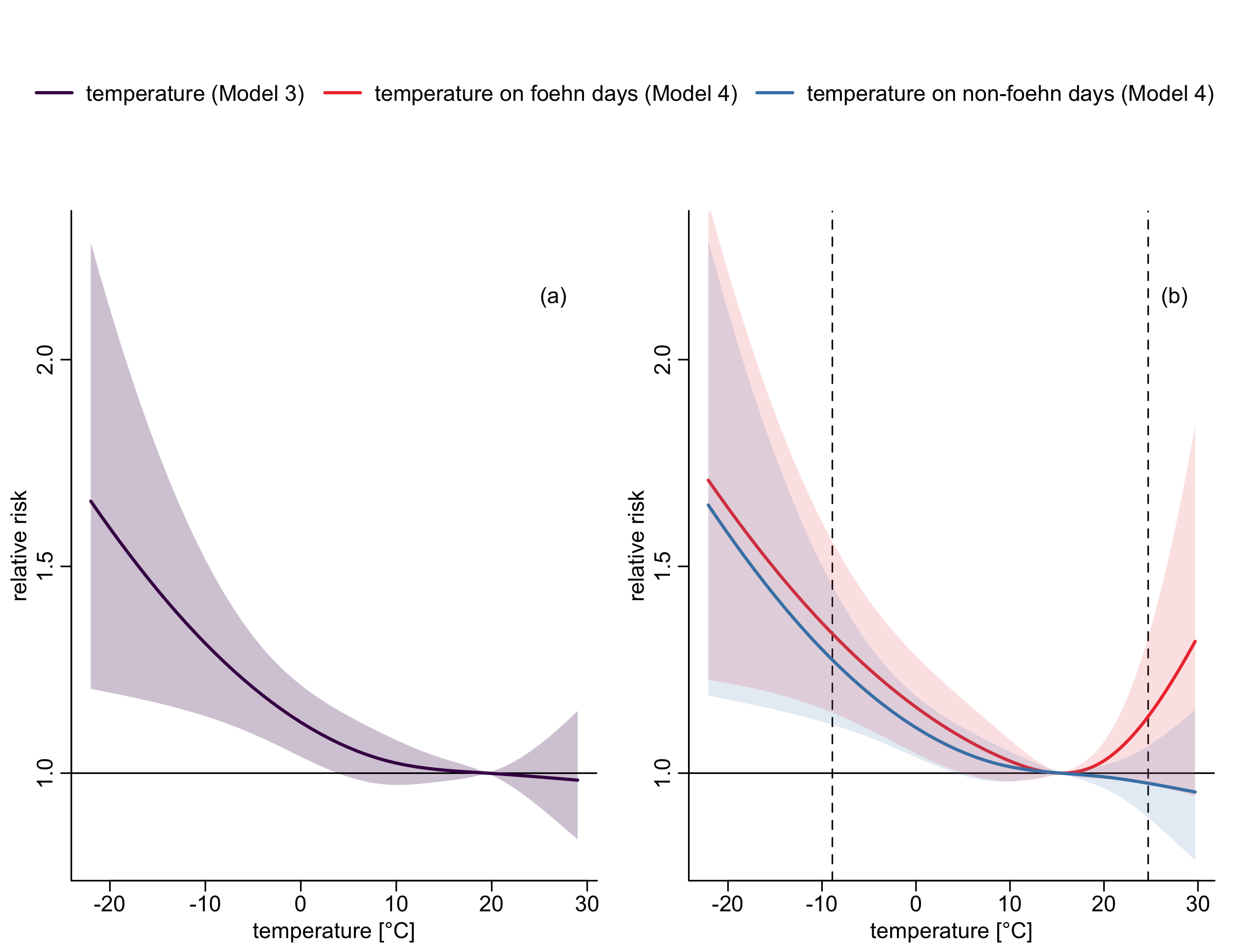Scientific publications
2025 Schneidewind T, Lee S, Vicedo-Cabrera A M, Saucy A. The risk of hospitalization associated with foehn winds and temperature in the mountainous region of Switzerland, Environmental Epidemiology. [Code]
Click here to see summary and key figure.
Foehn winds are intense warm winds, common in mountain regions, but their health impacts and potential to exacerbate existing heat-related risks remain poorly understood. We investigated the independent and combined association of foehn winds and temperature with cause-specific emergency hospitalizations in Switzerland. We found that foehn winds daily intensity showed small and no consistent association with hospitalizations in temperature-adjusted and non-adjusted models. However, foehn winds amplified heat-related hospitalization risk with a 14% increase in risk at the 99th temperature percentile on foehn days, compared to -2% on non-foehn days (Figure below). The association was larger for females, older adults, and for hospitalizations due to respiratory and mental health causes. While foehn winds did not directly impact hospitalizations, they may contribute to an amplification of heat-related health risks, especially for females and older adults.

Scientific Reports (non-peer reviewed)
Theses
2025 Master thesis. The risk of hospitalization associated with foehn winds and heat in the mountainous region of Switzerland, University of Bern, Switzerland. [Code]
Click here to see summary and key figure.
Foehn winds are intense warm winds, common in mountain regions, but their health impacts and potential to exacerbate existing heat-related risks remain poorly understood. We investigated the independent and combined association of foehn winds and temperature with cause-specific emergency hospitalizations in Switzerland. We found that foehn winds daily intensity showed small and no consistent association with hospitalizations in temperature-adjusted and non-adjusted models. However, foehn winds amplified heat-related hospitalization risk with a 14% increase in risk at the 99th temperature percentile on foehn days, compared to -2% on non-foehn days (Figure below). The association was larger for females, older adults, and for hospitalizations due to respiratory and mental health causes. While foehn winds did not directly impact hospitalizations, they may contribute to an amplification of heat-related health risks, especially for females and older adults.

2023 Bachelor thesis. Changes in precipitation distribution and intensity and their consequences on water balance in the Fichtelgebirge, northern Bavaria, University of Bayreuth, Germany.
Click here to see summary and key figure.
Climate change has intensified and altered precipitation patterns, with locally heterogeneous impacts that may affect regional water balance trends. In the Fichtelgebirge—a low mountain range in northern Bavaria—extreme precipitation and its consequences have not yet been systematically studied. This thesis investigates trends in precipitation and water balance from 1994 to 2022, focusing on changes in precipitation distribution, particularly extremes. Using precipitation indices, event-based analysis, and sub-daily data, the study finds a decline in both overall precipitation and water balance, including extreme precipitation events (figure below). These findings suggest that decreasing water availability may increase the risk of drought in the region in the future.

Reports
2025 Schneidewind T, Kessler L, Rigny T, Stajic D. Air pollution and emergency room visits, University of Bern, Switzerland. [Code]
Click here to see summary and key figure.
In the past decade, research on the health impacts of air pollution has expanded significantly, with mounting evidence linking air pollutants to various acute and chronic health outcomes. Short-term exposure to PM10 (particulate matter with aerodynamic diameters ≤10 μm) has been consistently associated with increased hospitalizations, particularly for respiratory and cardiovascular conditions. Using time series analysis with distributed lag non-linear models, we observed that PM10 exposure was linked to a higher risk of emergency room visits in Basel, Switzerland (Figure below). This risk attenuated when adjusting for temperature as a confounding factor. However, periods of elevated heat amplified the risk, especially among males, older adults, and patients presenting with cardiovascular-related emergencies.

2024 Schneidewind T, Bächtold L. Tropical Cyclone Freddy: a Performance Assessment of AI Pangu-Weather Forecasts on ERA5-Data, University of Bern, Switzerland. [Code]
Click here to see summary and key figure.
Tropical Cyclone (TC) Freddy was an exceptional storm that broke multiple records. With a lifespan of 34 days, it became the longest-lasting tropical cyclone ever recorded. It also covered the second-longest distance and underwent a record-breaking seven rapid intensification events. This report evaluates the performance of AI-based Pangu-Weather forecasts in predicting such an extreme event. Specifically, it assesses Pangu’s forecasting accuracy at various lead times prior to Freddy’s landfall in Madagascar on February 21, 2023. This moment was chosen because accurate forecasts are most critical during landfall, when the potential for damage and loss of life is greatest. The evaluation shows that Pangu-Weather was able to predict the location of the pressure minimum reasonably well, consistent with findings by Bi et al. (2022). However, it tended to underestimate the intensity of the storm (Figure below). Forecast accuracy declined with increasing lead time, and the underestimation of intensity is likely due to the model’s limited spatial resolution. Such underestimations pose risks for coastal communities, where emergency responses—such as evacuations—depend on the predicted storm strength. Despite these limitations, Pangu-Weather demonstrates promising capabilities. Improvements in spatial resolution and initial condition accuracy could significantly enhance its performance in forecasting extreme events like tropical cyclones. Additionally, its low computational requirements compared to traditional numerical weather prediction models make it attractive for rapid, frequent, and cost-effective forecasting.

2024 Schneidewind T. Are Switzerlands Dogs Threatened by Future Unabated Global Warming?, University of Bern, Switzerland.
Click here to see summary and key figure.
Dogs play an important role in Swiss society—as working animals in military, police, search and rescue, and assistance roles, and as pets that enhance human well-being. However, like humans, dogs are increasingly vulnerable to heat stress due to anthropogenic climate change, particularly in urban environments where warming is amplified, especially at night. As temperatures rise, dogs rely more on evaporative cooling through panting. However, this mechanism becomes less effective with increasing humidity, losing all efficiency above 80% relative humidity. This makes hot and humid conditions particularly dangerous for canine thermoregulation. This report examines projected increases in heat stress for dogs under the high-emission RCP8.5 climate scenario. An adapted Humidex index incorporating humidity was used to assess changes in heat stress days, and the number of tropical nights (nTN) was analyzed to represent reduced nocturnal cooling (Figure below). Using four CORDEX model chains, two time periods were compared: 1971–2000 (historical) and 2071–2100 (future). Results indicate a significant rise in heat stress days and tropical nights, particularly in low-lying areas such as the Swiss Plateau and Ticino (with increases of up to 26 and 46 nTN, respectively). In contrast, higher elevations like the Alps and Jura are less affected. However, model predictions vary across regions, particularly near Lake Geneva and Lake Constance, highlighting localized uncertainties in minimum temperature projections. Overall, the findings suggest a marked increase in heat stress for dogs in densely populated areas under continued high emissions. Mitigation strategies—such as building cooling systems and wider use of canine cooling aids—will be essential to protect dog health in a warming climate.

